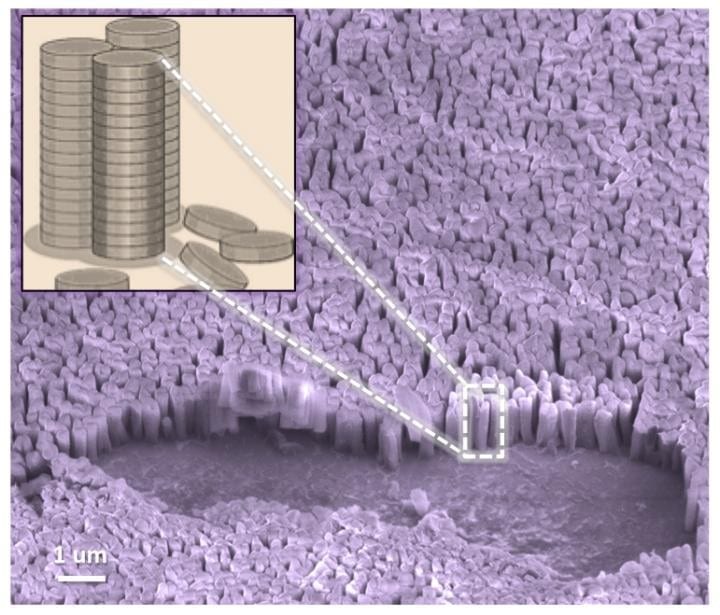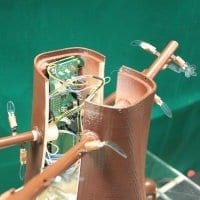
Credit: UMass AMherst
UMass Amherst scientists use graphene in new energy conversion architecture
Using a bio-mimicking analog of one of nature’s most efficient light-harvesting structures, blades of grass, an international research team led by Alejandro Briseno of the University of Massachusetts Amherst has taken a major step in developing long-sought polymer architecture to boost power-conversion efficiency of light to electricity for use in electronic devices.
Briseno, with colleagues and graduate students at UMass Amherst and others at Stanford University and Dresden University of Technology, Germany, report in the current issue of Nano Letters that by using single-crystalline organic nanopillars, or “nanograss,” they found a way to get around dead ends, or discontinuous pathways, that pose a serious drawback when using blended systems known as bulk heterojunction donor-acceptor, or positive-negative (p-n), junctions for harvesting energy in organic solar cells.
Briseno’s research group is one of very few in the world to design and grow organic single-crystal p-n junctions. He says, “This work is a major advancement in the field of organic solar cells because we have developed what the field considers the ‘Holy Grail’ of architecture for harvesting light and converting it to electricity.” The breakthrough in morphology control should have widespread use in solar cells, batteries and vertical transistors, he adds.
Briseno explains, “For decades scientists and engineers have placed great effort in trying to control the morphology of p-n junction interfaces in organic solar cells. We report here that we have at last developed the ideal architecture composed of organic single-crystal vertical nanopillars.” Nanopillars are nanoscale, engineered surfaces with billions of organic posts that resemble blades of grass, and like grass blades they are particularly effective at converting light to energy.
The Latest on: Organic solar cell
[google_news title=”” keyword=”Organic solar cell” num_posts=”10″ blurb_length=”0″ show_thumb=”left”]
via Google News
The Latest on: Organic solar cell
- Researchers outline path forward for tandem solar cellson April 26, 2024 at 7:23 am
As the old saying goes, two heads are better than one. The same is true when it comes to solar cells working in tandem. Researchers at the U.S. Department of Energy's National Renewable Energy ...
- Breakthrough in Organic Solar Cells Paves Way for Wearable Solar Poweron April 25, 2024 at 5:00 pm
An international group of scientists from the University of Hong Kong (HKU) has developed a new method to improve the efficiency and stability of organic solar cells, paving the way for integrating ...
- HKU Engineering researchers uncover the key to efficient and stable organic solar cellson April 25, 2024 at 2:03 pm
A team of researchers led by Professor Philip C.Y. Chow from the Department of Mechanical Engineering at the University of Hong Kong (HKU) has made a significant breakthrough in the field of organic ...
- Engineers uncover key to efficient and stable organic solar cellson April 25, 2024 at 7:56 am
A team of researchers led by Professor Philip C.Y. Chow from the Department of Mechanical Engineering at the University of Hong Kong (HKU) has made a significant breakthrough in the field of organic ...
- Key to efficient and stable organic solar cellson April 24, 2024 at 5:00 pm
Their research, titled "The role of interfacial donor-acceptor percolation in efficient and stable all-polymer solar cells," paves the way for more sustainable and viable solar energy solutions for ...
- A shade closer to more efficient organic photovoltaicson April 24, 2024 at 10:00 am
Transparent solar cells will transform the look of infrastructure by enabling many more surfaces to become solar panels. Now, materials called non-fullerene acceptors that can intrinsically generate ...
- Perovskite cells power palm-sized droneon April 24, 2024 at 4:19 am
Researchers at the Johannes Kepler University in Linz and the Linz Institute for Organic Solar Cells in Austria have developed ultra-lightweight quasi-2D perovskite solar cells with a power output of ...
- Polymer Solar Cells Market: Poised for a 21.5% Surge by 2027 – Powering a Sustainable Futureon April 21, 2024 at 11:39 pm
The global polymer solar cell market is poised for explosive growth, projected to reach a staggering US$ 290 million by 2027 with a CAGR of 21.5%. This presents a groundbreaking opportunity for ...
- Solar cells 20 times thinner than a strand of human hairon April 18, 2024 at 12:42 am
Solar-Powered Drones Support Sustainable Aviation. Developed by researchers at the Johannes Kepler University Linz, the new and ...
- Four-terminal tandem organic solar cell achieves 16.94% efficiencyon April 17, 2024 at 1:06 am
Researchers in Spain claim to have recorded the highest power conversion efficiency result for a four-terminal tandem organic cell to date. The device is based on an ultrathin transparent silver ...
via Bing News










